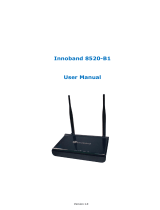
iiiD-Link DSL-G225 Wireless N300 ADSL2+/VDSL2 Modem Router User Manual
Table of Contents
Bridge Filtering ...............................................................65
Firewall Settings ..................................................................66
DNS ..........................................................................................67
Dynamic DNS .......................................................................68
Storage Device Information ............................................ 69
Storage Device Information .......................................69
Storage User Account ...................................................69
Network Tools ......................................................................70
Port Mapping ..................................................................71
IGMP ...................................................................................73
Quality of Service ...........................................................74
Queue Cong ..................................................................75
QOS Classication .......................................................... 76
UPNP ...................................................................................78
DSL ......................................................................................79
SNMP ..................................................................................80
TR-069 ................................................................................81
Certicates .......................................................................82
Routing ...................................................................................85
Static Route ......................................................................86
Default Gateway .............................................................87
RIP ........................................................................................ 88
Schedules ..............................................................................89
Print Server ............................................................................90
Maintenance ................................................................................91
System ....................................................................................92
Firmware Update ................................................................93
Access Controls ....................................................................94
Account Password .........................................................95
Services ..............................................................................96
IP Address .........................................................................97
Diagnostics ....................................................................... 98
System Log .......................................................................99
Status ........................................................................................... 100
Device Info ......................................................................... 101
Wireless Clients ................................................................. 102
DHCP Clients ..................................................................... 103
Logs ...................................................................................... 104
Statistics .............................................................................. 105
Route Info ........................................................................... 106
Help .............................................................................................. 107
Connect and Share a USB Device..................................108
Connect and Share a USB Storage Device ...................... 108
Connecting from a Windows Based PC ................... 110
Connecting from a Mac ................................................. 115
Connect a Wireless Client to your Router ....................119
WPS Button ................................................................................ 119
Windows® 10 ............................................................................ 120
Windows® 8 ................................................................................ 122
WPA/WPA2 ......................................................................... 122
Windows® 7 ................................................................................ 124
WPA/WPA2 ......................................................................... 124
Windows Vista® ......................................................................... 127
WPA/WPA2 ......................................................................... 128
Windows® XP ............................................................................. 130
WPA/WPA2 ......................................................................... 131




















